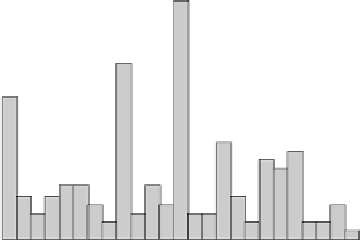Information Technology Reference
In-Depth Information
15
10
5
0
0
10
20
30
40
50
Number of unique values
Fig. 8.5
Distribution of unique values for descriptive features
8.4.1.3 Descriptive Features
Descriptive features represent the majority of features. These features provide tex-
tual descriptions of articles. Most features apply to a specific type of article. For
instance, the features “belt width” and “belt closure” apply to belts but not to hats.
Consequently, most descriptive features only cover a fraction of articles. Figure
8.4
illustrates this relation. We notice that few descriptive features assign values to all
or few transactions. Most features provide input for a subset of transactions. Con-
sistency represents a major issue for textual features. This issue occurs particularly
as values are manually entered. Figure
8.5
shows how the number of unique values
distributes across descriptive features. We observe that most features exhibit a small
number of unique values.
8.4.1.4 Customer-Related Features
The system receives customer-related features from two sources. On the one hand,
users create profiles describing their personal characteristics including age, height,
and weight. On the other hand, users fill out questionnaires about their tastes and
needs. In addition, customers may comment on their experiences having received
articles. We refer to this kind of features as
feedback-related
features. Figure
8.6
illustrates customers' weight, height, and age. We see that customers' age basically
ranges from 25 to 50 years with few exceptions. Conversely, both weight and height
are subject to substantial variances. Weights span from 55 to 120kg with some
outliers on both sides. Heights stretch from 165 to 205 cm with outliers in both
directions. Figure
8.7
shows the relative frequencies of individual trousers sizes.
This information is essential for selecting appropriate sizes. Equivalently, customers
provide their shoe, collar, and shirt sizes.






















Search WWH ::

Custom Search